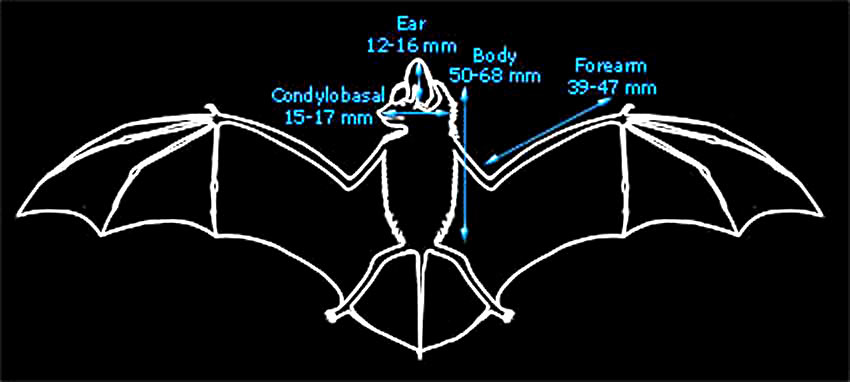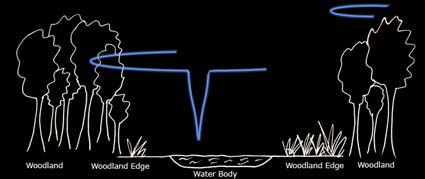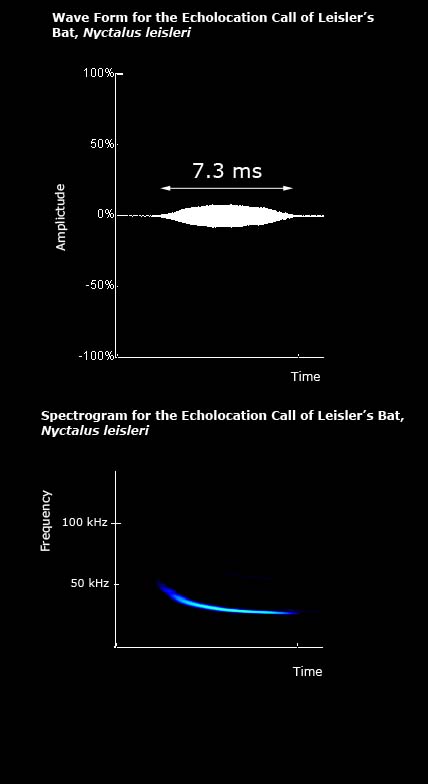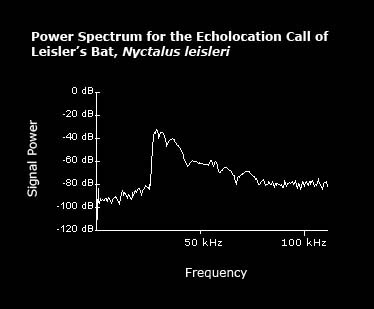Morphological Description
Life History
Distribution
Habitat
Roost Sites and Roosting Patterns
Emergence and Flight Pattern
Foraging Behaviour
Echolocation Calls
Status and Protection |
|
|
Morphological Description
- Dorsal fur is golden-brown. Ventral fur is yellow-brown.
- Juveniles are darker than adults.
- Facial skin and ears are dark, sometimes appearing black.
- Wings are long and narrow and often have hair.
- Tragus has a broad rounded tip, somewhat like a mushroom, and is as long as it is broad.
- The calcar extends to halfway between the foot and the tail.
- There is a pronounced post-calcarial lobe.
- The tail extends beyond the wing membrane.
- Average weight (as given by Greenaway & Hutson, 1990) 11-20 g.
The diagram below gives important average body measurements for Leisler's bats (Greenaway & Hutson, 1990).
|

Back to top |
Life History
- Mate from the end of August.
- A single young is born in mid-June.
- Work by Shiel et al. (1999) into the foraging behaviour of Leisler's bats in Ireland found that their foraging behaviour varied with reproductive stage. During pregnancy the bats fly farthest from their roost, and may make a second or third flight towards dawn on warmer nights. Pregnant bats also tend to vary the habitat they visit more than bats in different stages of reproduction. After birth the number of flights taken per night increases and the distance to the foraging site decreases up to the point of weaning due to increased energy demands of the young.
- Maximum age recorded in Europe is 9 years (Schober & Grimmberger, 1989).
Back to top
|
Distribution |
|
|
 |
| The British and World distributions are shown by the white areas of the maps above (as given by Richardson, 2000 and Corbet & Harris, 1991 respectively). |
|
Back to top
|
Habitat |
|
- Leisler's bats prefer open habitats and rivers or lakes (Vaughan et al., 1997).
- Often found in urban parks.
- Russ et al. (2003) found that Leisler's bats in Northern Ireland showed no seasonal variation in habitat use.
- The photograph on the left shows a typical habitat of Leisler's bats.
|
| Roost Sites and Patterns |
- Summer roosts: mainly buildings, often in trees and bat boxes, sometimes with noctules.
- Winter roosts: in larger groups from the end of September to the start of
April. In tree holes and crevices in buildings.
- Males hold a harem of up to 9 females in a mating roost.
- Nursery colonies of 20-50 females are common (Greenaway & Hutson, 1990).
Back to top
|
Emergence and Flight Pattern |
- Emerge early, around sunset.
- Median emergence time is 18 minutes after sunset (Jones & Rydell, 1994).
- Data collected in Northern Ireland found that the activity of Leisler's bats correlated with temperature (Russ et al., 2003).
- Activity of Leisler's bats has been found to be most intense in the first third of the night as this is when insects are most plentiful; this is not temperature-dependent. From this point onwards activity is related to temperature. In the last third of the night the temperature begins to rise and there is a second period of activity (Shiel & Fairley, 1998).
- Shiel and Fairley (1999) found that a colony Leisler's bats in Ireland often begin to emerge from the roost before sunset. During lactation periods when energy demands are higher the first emergence was earlier. The more overcast the evening, the earlier the emergence, although this may depend on the size of the exit hole. Heavy rain often repressed or disturbed emergence.
- Flies usually 10-70m above ground level (Russ, 1999).
- Flight is high and fast with turns and dives.
Back to top
|
Foraging Behaviour |
- Foraging activity peaks at dawn and dusk.
- Leisler's bats in Ireland were found to commute to their feeding sites at speeds of up to 40 km/h at a distance of up to 13.4km (Shiel et al., 1999).
- Waters et al. (1999) found that Leisler's bats foraged on average 4.2 km from their roost site in woodland and scrub-lined roads in Kent and over pasture in Bristol.
- The diet of Leisler's bats mainly consists of Diptera, particularly the suborder Brachycera (Vaughan, 1997).
- Shiel et al. (1998) investigated the diet of Leisler's bats in Ireland, England and Germany. They found that the bats eat mainly medium-sized and small insects, particularly Lepidoptera and those with aquatic larvae such as Trichoptera.
- A study of Leisler's bats around Bristol and Kent found that their diet varied seasonally and by location, but mainly consisted of small Nematocercan Diptera and smaller numbers of Coleoptera and Lepidoptera (Waters et al., 1999).
- Vaughan (1997) found that Leisler's bats predominantly eat aquatic Diptera, indicating that they mainly feed in close proximity to freshwater.
- Prey is caught and consumed during flight.
|
 |
|
Marked in blue on the diagram above is a typical foraging path of Leisler's bats (based on Russ, 1999).
Back to top
|
Echolocation Calls |
|
|
|


|
The echolocation call of Leisler's bats has a narrow bandwidth. |
|
To listen to the call of the Leisler's bat click here
Size of sound file: 12 KB
|

|
| For details of how the echolocation calls were recorded click here. |
|
Average values for a Leisler's bat echolocation call, as given by Vaughan et al. (1997), are listed below:
Interpulse interval: 226.0ms
Call duration: 10.9ms
Minimum frequency: 24.7kHz
Maximum frequency: 31.4kHz
The power spectrum on the left shows that the maximum power of the call is at a frequency of approximately 30 kHz.
|
Back to top
|
|
| Status and Protection
- The British pre-breeding population was estimated at 10,000 in 1995 (9750 in England, 250 in Scotland) (Harris et al., 1995).
- Rare in Britain.
- Leisler's bats are on the verge of becoming a threatened species worldwide (IUCN status, 2001).
- Bat boxes can be used to help maintain existing population levels.
Back to top
|
 © School of Biological Sciences, University of Bristol 2005. Last modified 24th February 2005. © School of Biological Sciences, University of Bristol 2005. Last modified 24th February 2005. |




 © School of Biological Sciences, University of Bristol 2005. Last modified 24th February 2005.
© School of Biological Sciences, University of Bristol 2005. Last modified 24th February 2005.